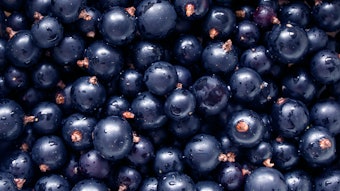2,5-Dimethyl-4-hydroxy-3(2H)-furanone (DMHF), also called ’’furaneol," was described as being “burnt pineapple’’-like and is the major character impact compound of pineapple flavor concentrate (Rodin, et al., 1965). DMHF has been identified in pineapple (Rodin, et al., 1965), strawberry (Re, et al., 1973; Pickenhagen, et al., 1981), mango (Pickenhagen, et al., 1981) and arctic bramble (Kallio, 1976). The stability of DMHF has been studied (Hirvi, et al., 1980; Shu, et al., 1985). It is somewhat unstable in air and in an aqueous solution. Hirvi, et al. (1980) reported that furaneol can be totally destroyed during the processing or canning of fruits such as pineapple. On the contrary, Lee and Nagy (1987) noted that canned pineapple samples showed the presence of relatively high amounts of DMHF as compared with fresh pineapple juice, and that for grapefruit juice, increasing the temperature and storage period caused more DMHF to form and accumulate. They attributed their observations to the formation of DMHF from the degradation of sugars either during processing or during subsequent storage.
This paper reports evidence of the presence of glycosidically bound DMHF in pineapple. In the last few years the analysis of flavor precursors and intermediates, especially glycosides in fruits, has received increasing interest and attention (Strauss, et al., 1986; Schwab and Schreier, 1988).
Materials and Methods
Material: The 2,5-dimethyl-4-hydroxy-3(2H)-furanone (DMHF) was kindly provided by Firmenich Inc. (Princeton, NJ). Amberlite XAD-2 (20-60 mesh) and γ-valerolactone were purchased from Aldrich Chemical Co. (Milwaukee, WI). Almond β-glucosidase was obtained from Sigma Chemical Co. (St. Louis, MO). All solvents were HPLC grade from Fisher Scientific Co. (Springfield, NJ).










